If you’re looking to create a great nonprofit website RFP (or a website brief) for a mid-sized organization, you’re in the right place.
Creating a single document summarizing your website needs can feel really daunting. But it doesn’t need to be nearly as complicated as many folks make it.
Here’s a step-by-step process you can follow to make writing your nonprofit’s website RFP (and ultimately finding the perfect partner) a whole lot simpler.
Video Transcript
Hey there. If you’re looking to create a great nonprofit website RFP, or a website brief, you are in the right place.
I’m David. I’m one of the co-founders here at Wired Impact and we’ve been building nonprofit websites since 2009. So we’ve literally seen hundreds of nonprofit website RFPs over the years.
I’m happy to share what the best ones are doing. And also a template that you can use to create your own website RFP and ultimately find that perfect fit partner for your project.
And then at the end, I’m also happy to share the biggest mistake that we see nonprofits make when it comes to the whole RFP process that can end up costing a lot of time and money.
But before we do that, let’s start with the good stuff. I’ll share my screen and we can jump into using this template.
Filling Out the Nonprofit Website RFP Planner Worksheet
Alright, so here we are. This is our Nonprofit Website RFP Planner Worksheet. And we’re just going to work through each of these components piece by piece. You can download a copy and fill this out yourself.
And then ultimately what you can do is you can just use this worksheet, each of these pieces, and that will become your RFP. Each of these can become a section of the RFP and you’ll have all the details that you need to make the whole writing process really easy and straightforward.
And I do recommend you fill this out solo before bringing in other folks on your team. You can definitely bring in key stakeholders for feedback, but if you try and fill this out with a group, it often leads to a “too many cooks in the kitchen” situation where everyone wants to get their ideas in here. And ultimately the RFP isn’t as strong as it could be.
Primary Audience
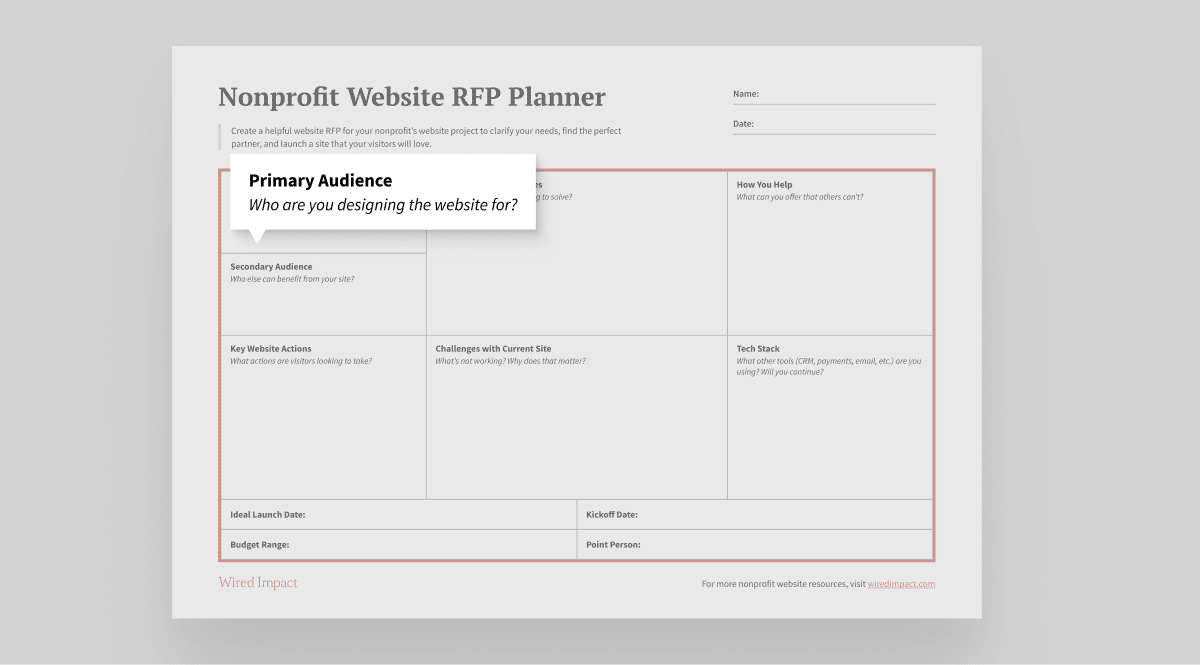
So for starters, we’ll zoom in on this primary audience box and this is who you’re designing the website for.
Now I always push nonprofits to try and limit yourself to one or two audiences max. I know that’s really tough, but really push yourself here because the best nonprofit websites are really clear on who they’re primarily trying to reach.
And these are ultimately the folks that you are going to keep top of mind as you’re answering all the questions in this worksheet. But even more than that, these are the folks you’re going to keep top of mind throughout the entire website project. These are the folks you really want to prioritize.
Secondary Audience
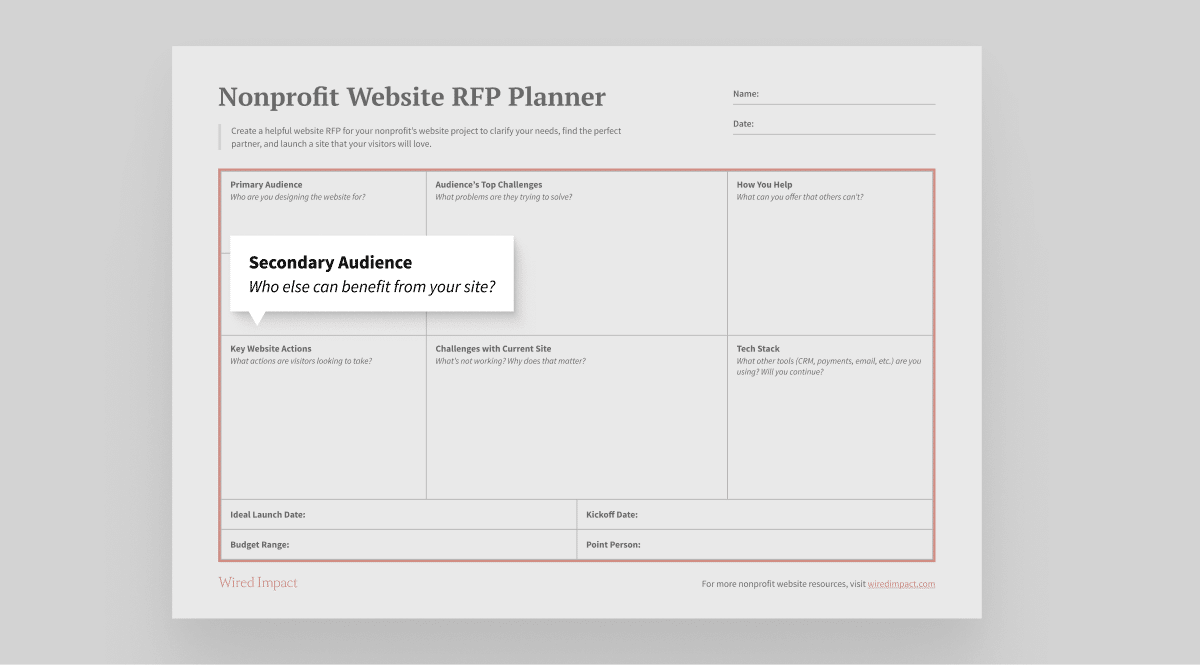
But your primary audiences are not the only people that can benefit from your website. Which brings us to secondary audiences. These are all the other people that can potentially benefit from using your website.
So here you can just list out anyone you can think of. List out as many folks as you can think of. You can always cut down the road.
But it is important to remember these are secondary audiences and so you really want to prioritize the primary audience as much as you possibly can throughout the entire project.
Audience’s Top Challenges
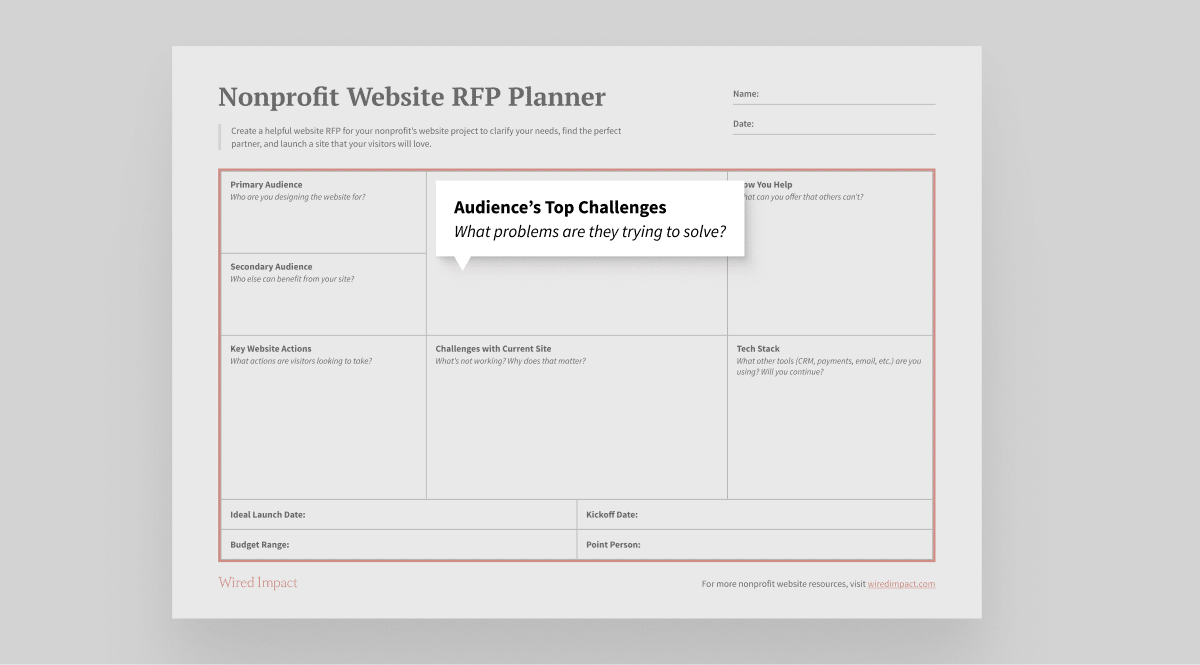
Alright, so now that we know our audiences, we’re going to turn our attention to their top challenges right here.
And these are the problems that our audiences are trying to solve. Or put another way, the pains that they’re feeling.
And really what this amounts to is this is going to be the motivation that is bringing your visitors to the website, their motivation.
And really this has implications for all kinds of things that are kind of come up throughout your project. Things like the structure of your site or what features you build, what calls to action you include on pages, what content you create in the first place. And even going as far back as how you’re going to drive traffic to the website.
All of those things should be funneled through the challenges that your audience is facing. And getting really clear on those challenges is going to make each of those decisions much, much easier.
Now one quick note, I actually do recommend coming up with your audience’s top challenges for both your primary and your secondary audiences. Again, you’re going to prioritize your primary audiences.
But just getting clear on what challenges each of your audiences is facing will make it a lot easier to work through the rest of this worksheet. They’ll just sort of serve as a list of challenges that you can then work on addressing.
So I would just pull your audiences over into this box and then list out the challenges that each is facing.
How You Help
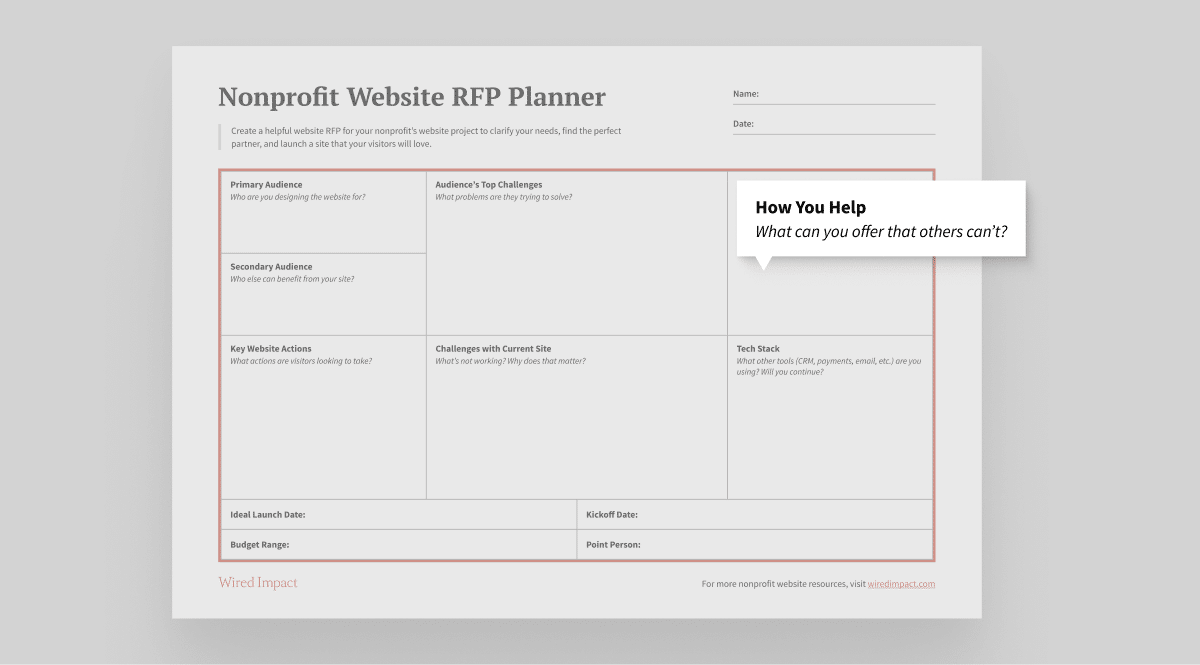
Once you’re really clear on your audience’s challenges, you can turn your attention to how you help. How do you solve those challenges for your audience?
And it’s okay if you don’t solve all of those challenges. Focus on the ones that you do solve well and ask yourself this question, “what can you offer that others can’t?”
This is ultimately going to be what’s called your “differentiated value.” This is what you can offer to your community that other organizations can’t. And for most organizations, this is going to be the way that you can really change the world for the people that you connect with.
Key Website Actions
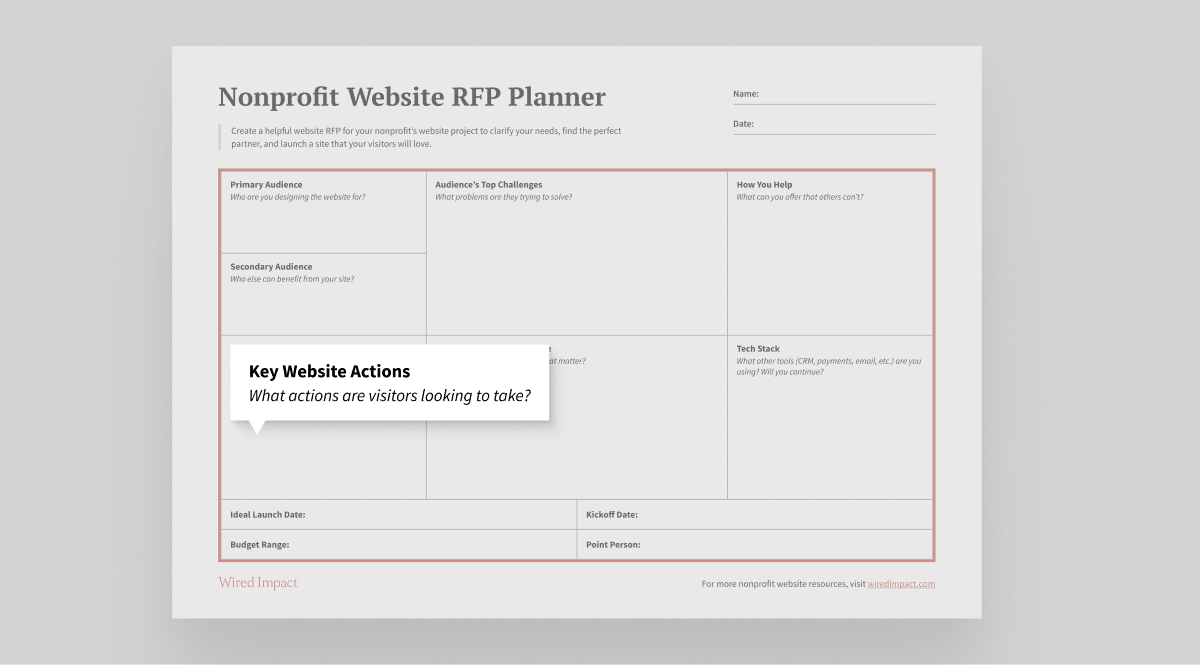
Okay, so now we’re going to get into the website itself.
Pitfall to Avoid: A lot of organizations at this point will jump right into listing out features, but it’s actually much more helpful if instead of features, you focus on these key website actions.
And then ultimately you can use that to inform the features that you build. But features are just a means to an end.
So start with these actions and then you and your website partner can work backwards to figure out what features are going to get your visitors there.
In terms of what actions go in this box, it’s really going to depend on the needs of your audience, the ways that you help, all of that kind of good stuff. But there are some common ones.
So I mean a lot of organizations are going to have something along the lines of a way for folks to make donations. Other audiences are going to be looking for maybe volunteer opportunities. (Apologies if you can’t read my handwriting.) Volunteer opportunities or other ways to get involved, other ways to get involved. It could be more of an early stage information gathering. So maybe they want to know more about your cause, more about cause and ways you help, right? Ways you help. So this could be the kind of thing that would lead people to signing up for your email list or reading thought leadership content that you create.
Maybe they’re looking for just ways to connect with your organization, right? So this would push them to social channels or an email list, something like that. Maybe they’re looking for information about events that you run.
Again, this will be unique to your audience and to the ways that you interact with them. But really kind of hone in on what actions your visitors would be looking to take. And then once you get really clear on that, you can work backwards to what features are going to help your visitors get there.
Challenges with the Current Website
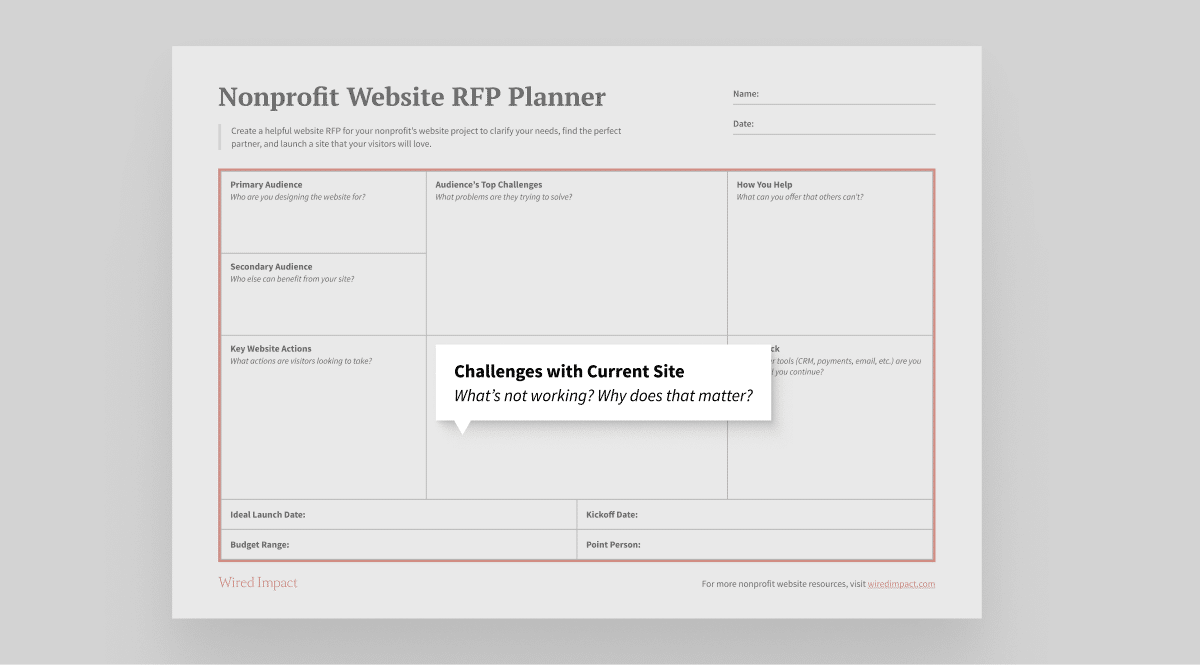
Now we’ll turn our attention to challenges with the current websites. Honestly, this is oftentimes one of the easiest boxes for nonprofits to fill in and here you’re going to want to focus on both what’s not working, but also why does that matter? So the what and the why.
And answering both of those questions will provide potential partners with just really helpful context that you’re bringing to the project.
It’ll help them answer the question of why are you taking this project on right now? And understanding these issues that you’re having with your current website will just make it much more likely that you can avoid repeating those issues with the new website that you’re building.
Tech Stack
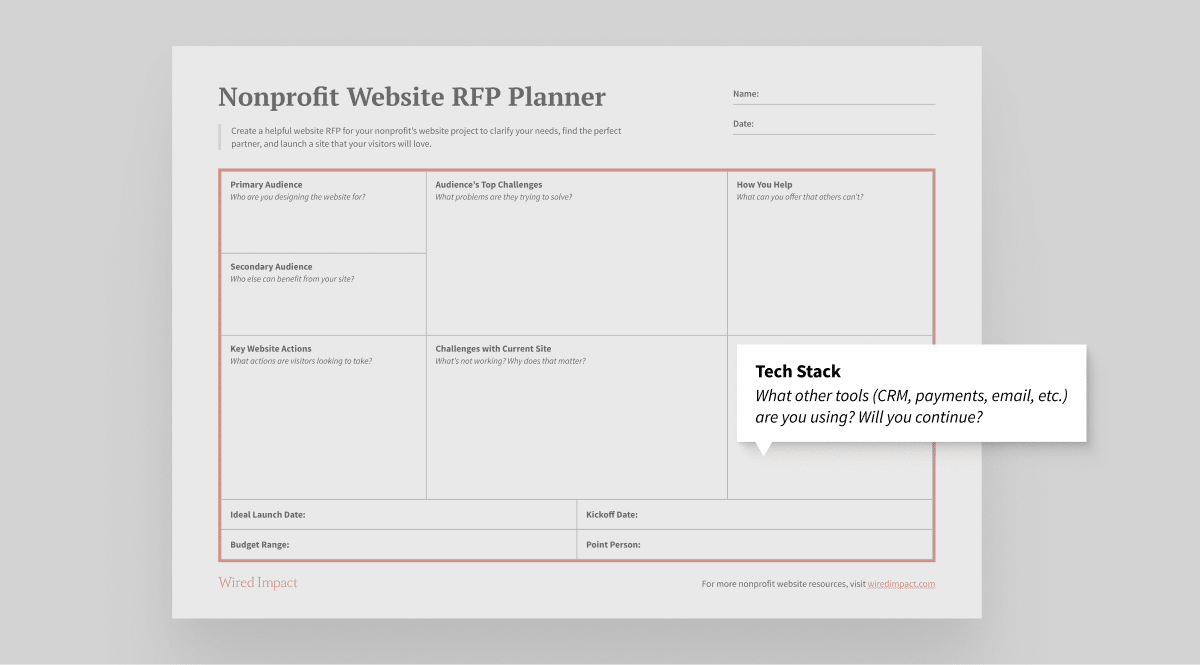
Now we’re going to turn our attention to your tech stack, which is just a fancy way of saying what tools are you using?
So what other tools are you using here? And will you continue to use those tools moving forward? And really just list out any tools that you can think of that you’re using for your website but also your marketing more generally because it’ll help your partner connect some dots.
So this could include things like donor management systems or CRMs. You know, it could include things like email marketing tools, or maybe like pop-up systems, pop-up tools that you’re using. Could include maybe payment processors.
Or maybe you’re using a mapping tool for some sort of maps.
Maybe you’re using a tool for volunteer management. It’s a pretty common one that we see for organizations that have a lot of volunteers.
Maybe you’re using third party tools, like a Google Tag Manager or pixels from social channels or maybe Zapier to connect some third party tools.
Really whatever tools you’re using, just list those out here and make a note of whether or not you’re going to continue to use those. It’ll just help your potential partner really firm up the scope of everything that’s going to be involved. All the moving pieces that are going to go into your project.
Ideal Launch Date
So we are on the home stretch here. I’m just going to fill in these last few items. First one is right here, our ideal launch date. And here you’re just going to note when you need the website live and also why that date.
Do you have a big event? Is that more of like a target date? Just knowing how rigid that date is will be really helpful. So you can work backwards to making that happen.
And then also note any key milestones that you have along the way. Maybe you have a board retreat or something where you want to be able to show a draft of the website just to get people excited. Noting anything like that will be really useful.
Pitfall to Avoid: You do not need to create a detailed timeline. Leave that up to your website partner.
Spend your time on these other higher leverage things like answering the questions in this worksheet. It’s really your partner’s job to be the expert on how to bring your vision to life and create a website that your visitors will love. It’s your job to be an expert on your mission and your needs and your audience.
Kickoff Date
The next one here is your kickoff date. When are you hoping to get started? When will you have the capacity to devote to a project like this?
Be realistic on your end, but also let your partners know, hey, this is the timeline we’re working on just to make sure that there is no misunderstanding about when you’re hoping to break ground on the new project.
Budget Range
Next up, we’re going to jump over here to budget range.
Now I know some organizations are reluctant to include a budget and I totally get it. You don’t want someone to start seeing dollar signs and just jack up the price to maximize the budget that you put down.
But I always recommend including some sort of budget, even if it’s a pretty broad range. It’s going to help in a few ways.
First, it’s going to strengthen the quality of partner that’s willing to submit a response to your RFP in the first place. A lot of the best shops I know won’t even bid on projects that there’s no sense of a budget at all.
And then it’s also going to avoid wasting your time. You’re going to end up reviewing a lot of proposals and answering a lot of questions for partners that might have just known from the beginning they weren’t a fit based on budget.
And on top of that, the best partners out there are going to work with your budgetary constraints to figure out ways to get creative and still meet the needs of your visitors, meet kind of the the vision of the project you’re looking for, but work creatively within those budgetary constraints that honestly are inherent to working with a lot of nonprofits.
And so again, I always recommend some sort of broad range. Obviously it’s up to you what you disclose when you disclose it, but I think you’ll have better results if you include some sort of range, even if it’s a pretty big one.
Point Person
And the last item we’re going to fill in here, it’s right over here. Who’s the point person on your team?
So this is who is going to be running point. I always recommend assigning a single point of contact even if multiple people are going to be involved.
And how should people reach out if they have questions? Do you prefer phone? Do you prefer email?
Just getting really clear on the best lines of communication from the beginning are going to streamline the entire process.
Using this Worksheet to Create Your Nonprofit’s Website RFP
And that’s it. So now turning this into an actual nonprofit website RFP, what I recommend is just use each box here and use each label as a heading in your actual RFP document.
So start with your audience, go into their challenges, go into how you help and just follow kind of sequentially through this worksheet. Turn each section into a heading and write your answers directly in there. So hopefully it’s pretty easy now to take all the heavy lifting you’ve done in this worksheet and turn that into your nonprofit website RFP.
Most Common Nonprofit Website RFP Issue to Avoid
Now before we part ways, I promised that I would cover the most common nonprofit website RFP related issue that we’ve seen over the years.
By far the most common issue we see nonprofits make when it comes to their RFP doesn’t have anything to do with the RFP itself. It’s the process that they follow.
Specifically, it’s having a very rigid process that doesn’t allow for conversation. And normally organizations cite one of two reasons. Either it’s to save time or in the interest of fairness to all parties involved.
But I actually don’t think either one of those really holds water if you tease them out.
So in terms of saving time, the biggest time waster that you can possibly have in this process is picking the wrong partner. And you’ll also end up wasting a bunch of money if you go that route.
So I always recommend slow the process down, have meaningful conversations with each partner, and then walk away confident that you’re choosing the right person to help bring your vision to life.
And then the other point about fairness, honestly, the point of this process is not to be fair, it’s to find that perfect partner. You want a partner that’s thoughtful and asks great questions and is willing to invest the time to get to know you and is going to look for creative solutions to whatever problems you’re facing.
By not having conversations with partners early in the process, you’re disadvantaging organizations that have all of those qualities.
A lot of folks that I know that do great work and create amazing websites for nonprofits, won’t even enter into the bidding process if an organization is unwilling to talk to them. So I always really strongly recommend slow the process down. Really take the time to get to know each organization that you’re potentially going to partner up with and walk away from the process sure that you’re making the right choice.
That will ultimately be the way that you can have the greatest success with your nonprofit website RFP and create a website that your visitors are going to love.
So I hope that this was helpful. If you have any questions, please don’t hesitate to reach out. We are always happy to help and we’ll see you next time.
Have a question about your nonprofit website RFP?
Or a question about filling out your RFP Planner worksheet?
If you’re wondering about it, there’s a good chance other nonprofits are too.
Feel free to drop them in the comments below. We’re happy to answer what we’ve seen work for other nonprofits and point you in the right direction.
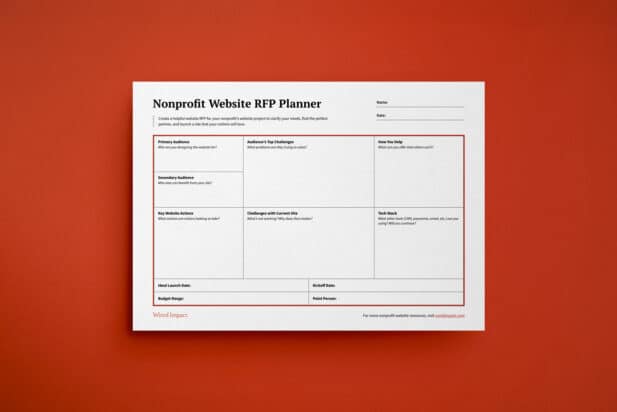
Thank You for this post we are in the first leg of a rebuild of our website as well as rebranding our logo, I have downloaded the worksheet and sent it over to our director.
You’re welcome Jeff! If any questions come up as you all dive in, definitely let us know. Happy to share what we’ve seen work well for other nonprofits.